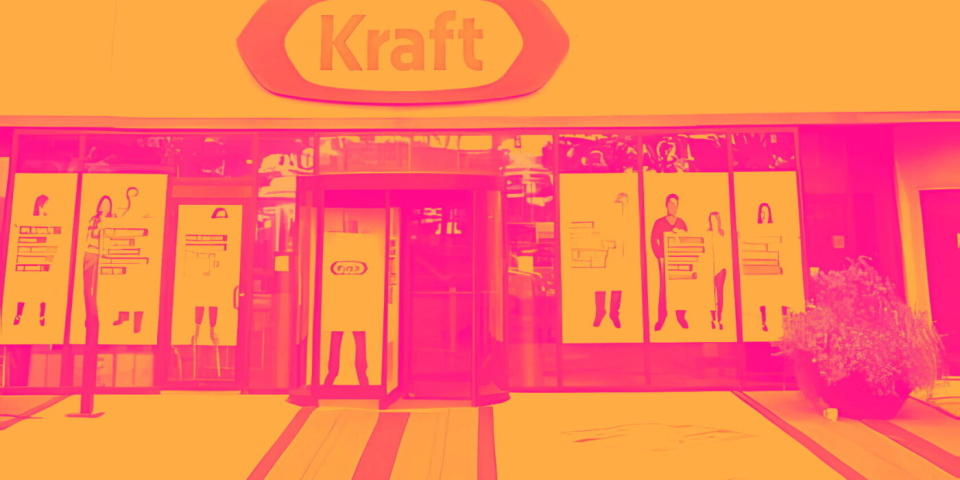Kraft Heinz (NASDAQ:KHC) Reports Sales Below Analyst Estimates In Q2 Earnings

Packaged foods company Kraft Heinz (NASDAQ:KHC) fell short of analysts' expectations in Q2 CY2024, with revenue down 3.6% year on year to $6.48 billion. It made a non-GAAP profit of $0.78 per share, down from its profit of $0.79 per share in the same quarter last year.
Is now the time to buy Kraft Heinz? Find out in our full research report.
Kraft Heinz (KHC) Q2 CY2024 Highlights:
Revenue: $6.48 billion vs analyst estimates of $6.56 billion (1.3% miss)
EPS (non-GAAP): $0.78 vs analyst estimates of $0.74 (5.7% beat)
EPS (non-GAAP) Guidance for the full year is $3.04 at the midpoint, beating analysts' estimates by 1.1%
Gross Margin (GAAP): 35.4%, up from 33.6% in the same quarter last year
Free Cash Flow of $1.17 billion, up 145% from the previous quarter
Organic Revenue fell 2.4% year on year (4% in the same quarter last year)
Sales Volumes fell 3.4% year on year (7% in the same quarter last year)
Market Capitalization: $41.09 billion
“Our second quarter net sales growth came in lower than originally anticipated, as consumer sentiment remains cautious,” said Kraft Heinz CEO Carlos Abrams-Rivera.
The result of a 2015 mega-merger between Kraft and Heinz, Kraft Heinz (NASDAQ:KHC) is a packaged foods giant whose products span coffee to cheese to packaged meat.
Shelf-Stable Food
As America industrialized and moved away from an agricultural economy, people faced more demands on their time. Packaged foods emerged as a solution offering convenience to the evolving American family, whether it be canned goods or snacks. Today, Americans seek brands that are high in quality, reliable, and reasonably priced. Furthermore, there's a growing emphasis on health-conscious and sustainable food options. Packaged food stocks are considered resilient investments. People always need to eat, so these companies can enjoy consistent demand as long as they stay on top of changing consumer preferences. The industry spans from multinational corporations to smaller specialized firms and is subject to food safety and labeling regulations.
Sales Growth
Kraft Heinz is one of the most widely recognized consumer staples companies in the world. Its influence over consumers gives it extremely high negotiating leverage with distributors, enabling it to pick and choose where it sells its products (a luxury many don't have).
As you can see below, the company's revenue was flat over the last three years as consumers bought slightly less of its products. We'll explore what this means in the "Volume Growth" section.

This quarter, Kraft Heinz missed Wall Street's estimates and reported a rather uninspiring 3.6% year-on-year revenue decline, generating $6.48 billion in revenue. Looking ahead, Wall Street expects sales to grow 1.8% over the next 12 months, an acceleration from this quarter.
Today’s young investors likely haven’t read the timeless lessons in Gorilla Game: Picking Winners In High Technology because it was written more than 20 years ago when Microsoft and Apple were first establishing their supremacy. But if we apply the same principles, then enterprise software stocks leveraging their own generative AI capabilities may well be the Gorillas of the future. So, in that spirit, we are excited to present our Special Free Report on a profitable, fast-growing enterprise software stock that is already riding the automation wave and looking to catch the generative AI next.
Volume Growth
Revenue growth can be broken down into changes in price and volume (the number of units sold). While both are important, volume is the lifeblood of a successful staples business as there’s a ceiling to what consumers will pay for everyday goods; they can always trade down to non-branded products if the branded versions are too expensive.
To analyze whether Kraft Heinz generated its growth from changes in price or volume, we can compare its volume growth to its organic revenue growth, which excludes non-fundamental impacts on company financials like mergers and currency fluctuations.
Over the last two years, Kraft Heinz's average quarterly sales volumes have shrunk by 2.9%. This decrease isn't ideal as the quantity demanded for consumer staples products is typically stable. Luckily, Kraft Heinz was able to offset fewer customers purchasing its products by charging higher prices, enabling it to generate 4.2% average organic revenue growth. We hope the company can grow its volumes soon, however, as consistent price increases (on top of inflation) aren't sustainable over the long term unless the business is really really special.

In Kraft Heinz's Q2 2024, sales volumes dropped 3.4% year on year. This result was a reversal from the 7% year-on-year increase it posted 12 months ago. A one quarter hiccup shouldn't deter you from investing in a business. We'll be monitoring the company to see how things progress.
Key Takeaways from Kraft Heinz's Q2 Results
It was good to see Kraft Heinz beat analysts' gross margin and EPS expectations this quarter. On the other hand, its revenue unfortunately missed Wall Street's estimates. Overall, this was a mediocre quarter for Kraft Heinz. The stock remained flat at $33.73 immediately following the results.
Kraft Heinz may have had a tough quarter, but does that actually create an opportunity to invest right now? When making that decision, it's important to consider its valuation, business qualities, as well as what has happened in the latest quarter. We cover that in our actionable full research report which you can read here, it's free.

 Yahoo Finance
Yahoo Finance 